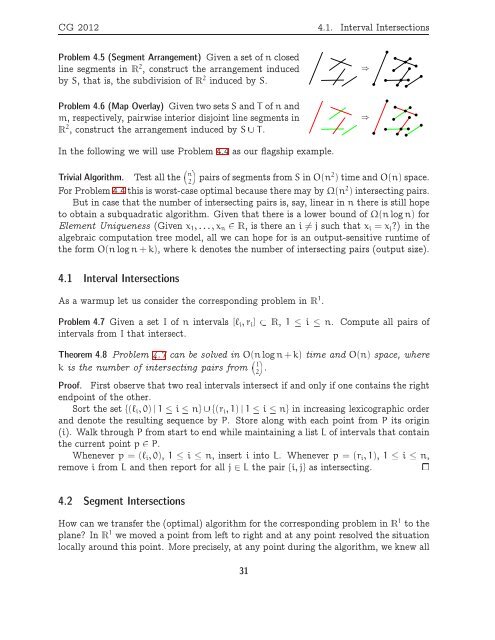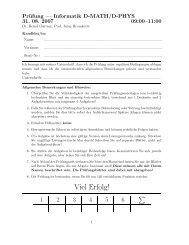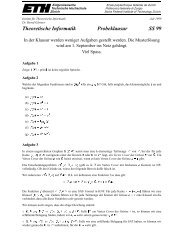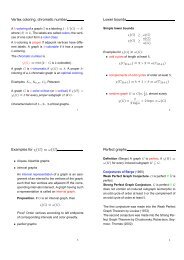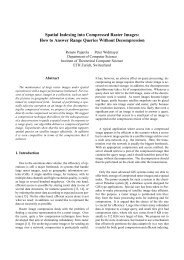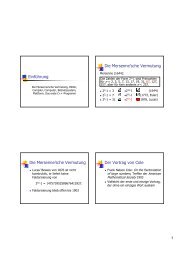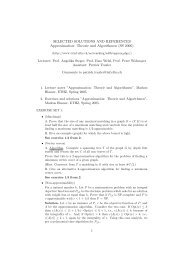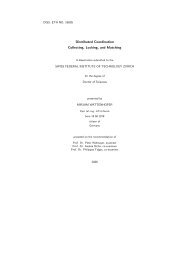Chapter 4 Line Sweep - TI
Chapter 4 Line Sweep - TI
Chapter 4 Line Sweep - TI
You also want an ePaper? Increase the reach of your titles
YUMPU automatically turns print PDFs into web optimized ePapers that Google loves.
CG 2012 4.1. Interval Intersections<br />
Problem 4.5 (Segment Arrangement) Given a set ofnclosed<br />
line segments in R 2 , construct the arrangement induced<br />
by S, that is, the subdivision ofR 2 induced by S.<br />
Problem 4.6 (Map Overlay) Given two setsSandT ofnand<br />
m, respectively, pairwise interior disjoint line segments in<br />
R 2 , construct the arrangement induced by S�T.<br />
In the following we will use Problem 4.4 as our flagship example.<br />
Trivial Algorithm. Test all the�n<br />
2�pairs of segments fromSinO(n 2 ) time and O(n) space.<br />
For Problem 4.4 this is worst-case optimal because there may by Ω(n 2 ) intersecting pairs.<br />
But in case that the number of intersecting pairs is, say, linear in n there is still hope<br />
to obtain a subquadratic algorithm. Given that there is a lower bound of Ω(n logn) for<br />
Element Uniqueness (Given x1,...,xn R, is there an i�= j such that xi = xj?) in the<br />
algebraic computation tree model, all we can hope for is an output-sensitive runtime of<br />
the form O(n logn+k), where k denotes the number of intersecting pairs (output size).<br />
4.1 Interval Intersections<br />
As a warmup let us consider the corresponding problem inR 1 .<br />
Problem 4.7 Given a set I of n intervals [ℓi,ri]�R, 1�i�n. Compute all pairs of<br />
intervals from I that intersect.<br />
Theorem 4.8 Problem 4.7 can be solved in O(n logn+k) time and O(n) space, where<br />
k is the number of intersecting pairs from�I<br />
2�.<br />
Proof. First observe that two real intervals intersect if and only if one contains the right<br />
endpoint of the other.<br />
£<br />
Sort the set {(ℓi,0)|1�i�n}�{(ri,1)|1�i�n} in increasing lexicographic order<br />
and denote the resulting sequence by P. Store along with each point from P its origin<br />
(i). Walk through P from start to end while maintaining a list L of intervals that contain<br />
the current point p P.<br />
Whenever p = (ℓi,0), 1�i�n, insert i into L. Whenever p = (ri,1), 1�i�n,<br />
remove i from L and then report for all j L the pair {i,j} as intersecting.<br />
4.2 Segment Intersections<br />
How can we transfer the (optimal) algorithm for the corresponding problem inR 1 to the<br />
plane? InR 1 we moved a point from left to right and at any point resolved the situation<br />
locally around this point. More precisely, at any point during the algorithm, we knew all<br />
31<br />
⇒<br />
⇒


